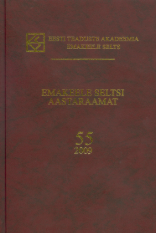/Õ/ HÄÄLDUSE VARIEERUMINE
VARIATION IN THE PRONUNCIATION OF ESTONIAN /Õ/
Author(s): Pire TerasSubject(s): Phonetics / Phonology, Finno-Ugrian studies
Published by: Teaduste Akadeemia Kirjastus
Keywords: phonology; phonetics; language variation; vowels; classification;
Summary/Abstract: There are 9 vowels in Estonian: /i, ü, u, e, ö, õ, o, ä, a/. Unlike other vowels the classification of the vowel /õ/ has been problematic. In the phonetic transcriptions /õ/ has been transcribed as [ɤ] or [ɯ] (IPA) or [e̮] (Finno-Ugric transcription). What are the possible reasons for this variance? This paper gives an overview of the results of experimental phonetic research focusing on the quality of /õ/: articulation, acoustics and perception. All these results, as well as phonetic transcriptions of Estonian dialects, point to variation in the quality of /õ/. In the articulation of different speakers the configuration of the body of the tongue and its height are similar to the close back vowel /u/ or to the close-mid back vowel /o/, but /õ/ is unrounded ([ɯ] or [ɤ]). In the acoustic analyses /õ/ has rather been compared to the close-mid vowels than close vowels, admitting that /õ/ can be closer than other close-mid vowels. Perception tests have shown that /õ/ occupies the space corresponding to both the close-mid and close vowels. The pronunciation of /õ/ can also vary due to the speaker’s regional background. Phonologically, /õ/ has been classified as an unrounded close-mid central or back vowel or unrounded close back vowel. Considering the phonetic variation of /õ/, a compromise in the classification of /õ/ can be that it is an unrounded non-open back vowel.
Journal: Emakeele Seltsi aastaraamat
- Issue Year: 2017
- Issue No: 63
- Page Range: 221-239
- Page Count: 19
- Language: Estonian

